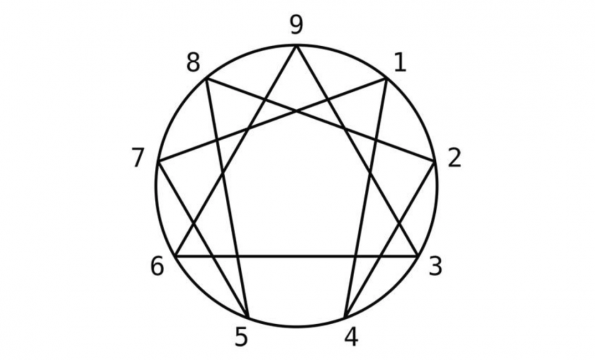The Gospel Coalition, by Kevin DeYoung: If you haven’t heard of the Enneagram yet, it won’t be long before you do.
After being used for several decades in Catholic retreats and seminars, the nine-type personality tool has seen an explosion of popularity in evangelical circles. Since 2016, evangelical publishers have released at least three-full length books on the Enneagram . . . . A new book . . . is set to release in April [2018].
Beyond books, the Enneagram (pronounced any-a-gram) continues to receive a warm reception on a number of blogs and evangelical media outlets with articles like: “What All Christians Need to Know About the Enneagram” and “The Never Ending Quest to Know Ourselves.” In particular, Christianity Today has been a frequent advocate of the Enneagram, touting what the Enneagram has to offer Christians, how evangelicals can use it, and, just recently, how it can be a tool for pastors. On a personal note, I have good friends who swear by the Enneagram as the means by which God showed them their blindspots and helped them overcome weaknesses in their personality.
So what should we make of this new (or ancient?) personality wheel with a strange name?
I want to get at the question in a simple, straightforward—and admittedly limited—way. I’m going to look at The Road Back to You by Ian Morgan Cron and Suzanne Stabile. I’ve chosen this book for several reasons: it was the first one (so far as I know) to come out with an evangelical publisher, it has been successful enough to spawn a soon-to-be-released sequel, and its authors are popular experts on all things Enneagram.
I understand that some fans of the Enneagram will say, “But that’s not what I believe!” Or, “That’s not how I use it!” I get that. It’s a tool that can be adopted and adapted to a variety of theologies and contexts. But you have to start somewhere, and The Road Back to You seems as good a place as any to dive in and interact with this increasingly popular tool of self-discovery. Hereafter in this post, my analysis with the Enneagram will be through reviewing this single book.
Ok, enough preface. What are we actually talking about?
The Enneagram teaches that there are nine different personality styles in the world, one of which we naturally gravitate toward and adopt in childhood to cope and feel safe. Each type or number has a distinct way of seeing the world and an underlying motivation that powerfully influences how that type thinks, feels and behaves. (24)
While the ancient roots of the Enneagram are sketchy—maybe it started with a monk, maybe with Sufism, maybe with occult practices—most everyone agrees that the modern Enneagram entered America by way of the psychiatrist Claudio Naranjo, a student of a Chilean named Oscar Ichazo who rediscovered the Enneagram in the early 1970s. From Naranjo, the Enneagram entered the Catholic world through Father Robert Ochs, and then later made another splash when the Franciscan Friar Richard Rohr began writing and speaking on it (10-14).
At first glance, the Enneagram may look like just another personality test, along the lines of discovering your Myers-Briggs type, knowing the color of your parachute, finding your strengths, or realizing you’re a golden retriever instead of a beaver. But Cron and Stabile are adamant that the Enneagram is much more than a psychological profile. “The true purpose of the Enneagram is to reveal to you your shadow side and offer spiritual counsel on how to open it to the transformative light of grace” (31). Growing up, we learn to cope with the emotional wounds we receive in childhood. In order to protect us from pain, we “place a mask called personality over parts of our authentic self” (22).
The Enneagram is not the end-all and be-all of Christian spirituality, Cron and Stabile acknowledge, but it is an incredibly useful tool God can use to help restore us to our authentic selves (20, 23). “Buried in the deepest precincts of being,” Cron writes, “I sense there’s a truer, more luminous expression of myself, and that as long as I remain estranged from it I will never feel fully alive or whole” (23). At its root, the Enneagram is a healing message of self-knowledge and self-awareness (34). We all put on masks. We all struggle to feel like we are okay in the world and okay to be who we are. Enter the Enneagram as a tool for letting go of the stranger we’ve become (24). “The purpose of the Enneagram is to show us how we can release the paralyzing arthritic grip we’ve kept on old, self-defeating ways of living so we can open ourselves to experiencing more interior freedom and become our best selves” (36).
Our Comment:
The idea that one can discover the good in himself or herself is a teaching found in Buddhist and new age practices. It is slowly creeping into the church through various avenues, including the Enneagram craze.
Prophetic Link:
“As spiritualism more closely imitates the nominal Christianity of the day, it has greater power to deceive and ensnare. Satan himself is converted, after the modern order of things. He will appear in the character of an angel of light. Through the agency of spiritualism, miracles will be wrought, the sick will be healed, and many undeniable wonders will be performed. And as the spirits will profess faith in the Bible, and manifest respect for the institutions of the church, their work will be accepted as a manifestation of divine power.” Great Controversy, page 588.






Comments
Carlos Santibanez
Sunday December 22nd, 2019 at 11:13 PMThank you for posting this ! this needs to get more awareness, people are eating it up in the church